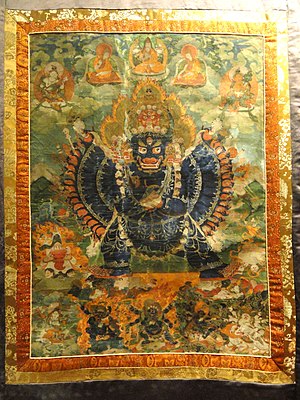Yamāntaka
Jump to navigation
Jump to search
Yamantaka (Skt. Yamāntaka; T. gshin rje gshed གཤིན་རྗེ་གཤེད་; C. Yanmandejia/Daweide ming-wang 焰曼德迦/大威德明王) is an important tantric deity.[1] He is a wrathful form of Manjushri, representing the wisdom that subdues death.[2]
The name Yamantaka literally means "Slayer of Yama," where Yama is the Lord of Death.[2]
Geshe Lhundrub Sopa states:
- Yama is the Lord of Death. Yamāntaka means “terminator (antaka) of Yama.” In many sutras and tantras ignorance is considered the most powerful spiritual enemy, and the perfect wisdom that eliminates this enemy is personified by Mañjuśrī, who is depicted with a flaming sword and a book; the flaming sword signifies the wisdom that cuts down the enemy of ignorance. This peaceful form of Mañjuśrī is the manifestation of perfect wisdom, but his wrathful form is Yamāntaka, the terminator of Yama. He is depicted as bearing many types of weapons, which he employs to destroy Yama. This is Yamāntaka’s outward form, but in his ultimate form, he is the inseparable combination of the wisdom that realizes emptiness with the highest bliss.
- In the dedication [of Wheel Blade of Mind Transformation] Yamāntaka is addressed as the Great Wrathful One, but his wrath is not the ordinary anger of deluded beings; actually, he is not angry at anyone, but in fact has great love and compassion toward all sentient beings. It is against spiritual enemies — the view of a real personal identity and the self-cherishing attitude — that his anger is directed. All bodhisattvas can be wrathful in this way, since it is the duty of the bodhisattvas to destroy the sources of misery for sentient beings. The buddhas have the highest form of wrath, because they have destroyed self-cherishing completely. Yamāntaka is a protector of the Dharma, which is why he appears in a wrathful form.[3]
The Princeton Dictionary states:
- According to Buddhist mythology, Mañjuśrī, the bodhisattva of wisdom, took the form of the terrifying bull-headed deity in order to destroy the Lord of Death (Yama) who was ravaging the country; hence the epithet Yamāntaka (Destroyer of Death). Yamāntaka has nine heads, thirty-four arms, and sixteen legs, each arm holding a different weapon or frightening object, and each foot trampling a different being. Each of these receives detailed symbolic interpretation in ritual and meditation texts associated with Yamāntaka.[1]
Notes
- ↑ 1.0 1.1 Buswell & Lopez 2014, s.v. Yamāntaka.
- ↑ 2.0 2.1
 Yamantaka, Rangjung Yeshe Wiki
Yamantaka, Rangjung Yeshe Wiki
- ↑ Lhundub Sopa, Sweet & Zwilling 2001, Commentary on Dharmarakṣita's The Wheel-Weapon Mind Training.
Sources
 Buswell, Robert E.; Lopez, Donald S. (2014), The Princeton Dictionary of Buddhism, Princeton University
Buswell, Robert E.; Lopez, Donald S. (2014), The Princeton Dictionary of Buddhism, Princeton University- Lhundub Sopa, Geshe; Sweet, Micheal J.; Zwilling, Leonard (2001), Peacock in the Poison Grove: Two Buddhist Texts on Training the Mind, Boston: Wisdom Publications
